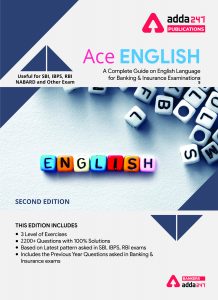Table of Contents
Directions (1-5): Rearrange the following six sentences (A), (B), (C), (D), (E) and (F) in the proper sequence to form a meaningful paragraph and then answer the questions given below.
(A) Like Gandhi’s mantra of swarajya, Modi has turned Swachh Bharat into a mass movement, a jan andolan that you cannot quarrel with whatever your political stripe.
(B) The smartest thing Prime Minister Narendra Modi did was to hitch the Swachh Bharat Mission (SBM) to the aura of Mahatma Gandhi.
(C) Modi has also been a constant communicator about Swachh Bharat in his speeches.
(D) From its official launch at Raj Ghat on Gandhi Jayanti 2014, the Clean India message has been omnipresent and relentless.
(E) Gandhi spoke and wrote prolifically, using his magazines Navajivan, Harijan and Young India, postcards, letters and telegrams.
(F) He also has the power of social media, and a Swachh Bharat app so you can take pictures of dirt and garbage that are geo-spatially tagged and hopefully cleaned up.
Q1. Which of the following would be the THIRD sentence after rearrangement?
(a) A
(b) B
(c) C
(d) D
(e) E
Q2. Which of the following would be the SECOND sentence after rearrangement?
(a) A
(b) B
(c) C
(d) D
(e) E
Q3. Which of the following would be the FOURTH sentence after rearrangement?
(a) A
(b) E
(c) C
(d) D
(e) F
Q4. Which of the following would be the SIXTH (LAST) sentence after rearrangement?
(a) A
(b) B
(c) C
(d) F
(e) E
Q5. Which of the following would be the FIRST sentence after rearrangement?
(a) A
(b) B
(c) C
(d) D
(e) E
Directions (6-13): Read each sentence to find out whether there is any grammatical or idiomatic error in it. The error, if any, will be in one part of the sentence. The alphabet corresponding to that part is your answer. If there is ‘No error’, the answer is (e). (Ignore errors of punctuation, if any.)
Q6. The priest together with (A)/his followers were fatally injured (B)/in the accident which occurred last night (C)/near the unmanned railway crossing. (D)/No Error (E)
(a) A
(b) B
(c) C
(d) D
(e) E
Q7. The young woman who is watching television in that room (A)/lived here for more than (B)/a year but she has never created (C)/any problem for us. (D)/No Error (E)
(a) A
(b) B
(c) C
(d) D
(e) E
Q8. Each of the employees, (A)/whom the company has chosen to take part (B)/in the international seminar to be conducted (C)/in the City Hall, are up to the mark. (D)/ No Error (E)
(a) A
(b) B
(c) C
(d) D
(e) E
Q9. Needless to say, (A)/no sooner were all these large and rather expensive operations finished (B)/when the main electricity was brought in (C)/and the turbine became obsolete. (D)/No Error (E)
(a) A
(b) B
(c) C
(d) D
(e) E
Q10. Plastic bags less than 50 microns thick (A)/are banned, (B)/but neither the states nor the city corporations (C)/cares to enforce this rule. (D)/No Error (E)
(a) A
(b) B
(c) C
(d) D
(e) E
Q11. Tribal angst over economic issues (A)/leading to the scapegoating of nontribal longtime residents (B)/reflects the continued failure (C)/to forge a more inclusive politics in Meghalaya. (D)/No Error (E)
(a) A
(b) B
(c) C
(d) D
(e) E
Q12. The Prime Minister has great power of (A)/implementing some useful (B)/schemes but the ministers (C)/have even greatest ability to foil them. (D)/No Error (E)
(a) A
(b) B
(c) C
(d) D
(e) E
Q13. The blunder mistake (A)/was the apparent failure of detectives (B)/to inform the Parole Board that the murderer (C)/had threatened to return to kill her. (D)/No Error (E)
(a) A
(b) B
(c) C
(d) D
(e) E
Directions (14-15): In each question below some sentences are given which are divided into five parts. The first part of the sentence (1) is correct and is given in bold followed by four parts named A, B, C and D. Rearrange the four parts of the sentence to make a coherent paragraph. The rearranged sequence of the parts will be your answer. If the given sentence is correct as it is then choose option (e).
Q14. Crashes in the early days (1)/ to be caused by technical faults, (A)/ of commercial jets tended (B)/ such as metal fatigue (C) /in the airframe or engines (D)
(a) DCAB
(b) ABDC
(c) BACD
(d) CABD
(e) No arrangement required
Q15. There have been a lot of (1)/ drivers not obeying (A)/ complaints recently about (B)/ in downtown Boston (C)/ the speed limits (D)/
(a) BADC
(b) ABDC
(c) BCAD
(d) CABD
(e) No arrangement required
Practice More Questions of English for Competitive Exams:
English for Competitive Exams |
English Language Quiz For SBI Clerk Prelims 2021- 19th May |
English Language Quiz For SBI Clerk Prelims 2021- 18th May |
SBI Clerk Study Plan 2021 |
Solutions
S1. Ans. (a)
Sol. The correct sequence of the sentences to form a coherent paragraph is BDAECF. Hence, option (a) is the most suitable answer choice.
S2. Ans. (d)
Sol. The correct sequence of the sentences to form a coherent paragraph is BDAECF. Hence, option (d) is the most suitable answer choice.
S3. Ans. (b)
Sol. The correct sequence of the sentences to form a coherent paragraph is BDAECF. Hence, option (b) is the most suitable answer choice.
S4. Ans. (d)
Sol. The correct sequence of the sentences to form a coherent paragraph is BDAECF. Hence, option (d) is the most suitable answer choice.
S5. Ans. (b)
Sol. The correct sequence of the sentences to form a coherent paragraph is BDAECF. Hence, option (b) is the most suitable answer choice.
S6. Ans (b)
Sol. In the second part of the sentence, the word “were” will be replaced by the word “was” because when two subjects are combined with ‘together with’, the main subject is the one which is written before together with, and the verb follows the main subject. All other parts of the sentence are correct. Hence, option (b) will be the correct answer.
S7. Ans (b)
Sol. In the second part of the sentence, the word “lived” will be replaced by “has lived” or “has been living” because “is watching” used in first part of the sentence and “has never created” used in the third part of the sentence signify that the sentence is in present tense. Hence, option (b) will be the correct answer.
S8. Ans (d)
Sol. In the fourth part of the sentence, “are” should be replaced by “is” because the subject of the statement starts with “Each of” and such sentences always follow singular Verb. Hence, option (d) will be the correct answer.
S9. Ans (c)
Sol. In the third part of the sentence, “when” will be replaced by “than” because ‘No sooner’ is always followed by ‘than’ and ‘Hardly/Scarcely’ is followed by ‘when/before’. Hence, option (c) will be the correct answer.
S10. Ans (d)
Sol. In the fourth part of the sentence, “cares” should be replaced by “care” because if two subjects are combined using ‘Either…or’ or ‘Neither…nor’ then the verb always follows the subject near to it, which in this case is ‘the city corporations’. So the verb will be plural. Hence, option (d) will be the correct answer.
S11. Ans (e)
Sol. All the parts of the given sentence are grammatically correct. Hence, option (e) will be the correct answer.
S12. Ans (d)
Sol. In the fourth part of the sentence, “greatest” should be replaced by “greater” because here we are comparing between two types of people, ‘Prime Minister’ and ‘Ministers’, and when we compare two types of people or things in Comparative Degree then the adjective used should also be of Comparative Degree. Hence, option (d) will be the correct answer.
S13. Ans (a)
Sol. The error lies in the first part of the sentence where the usage of the words ‘blunder’ and ‘mistake’ together is superfluous as ‘blunder’ itself means ‘a stupid or careless mistake’. Hence, option (a) will be the correct answer.
S14. Ans. (c)
Ans. The correct sequence of the other parts to form a grammatically correct and contextually meaningful sentence is BACD. Hence, option (c) is the most suitable answer choice.
S15. Ans. (a)
Sol. The correct sequence of the other parts to form a grammatically correct and contextually meaningful sentence is BADC. Hence, option (a) is the most suitable answer choice.
Click Here to Register for Bank Exams 2021 Preparation Material





 English Language Quiz For Bank Foundatio...
English Language Quiz For Bank Foundatio...
 English Language Quiz For SBI Clerk Prel...
English Language Quiz For SBI Clerk Prel...
 English Language Quiz For SBI Clerk Prel...
English Language Quiz For SBI Clerk Prel...




